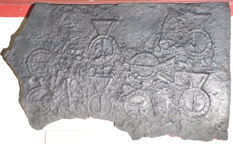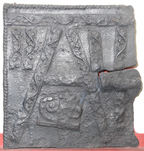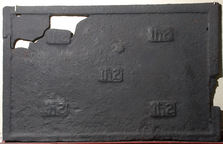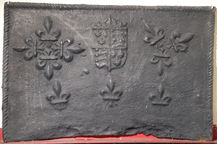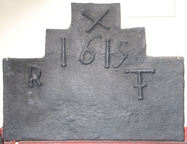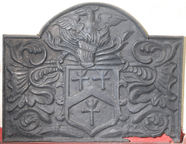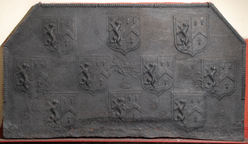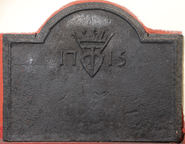-
380
Description: Damaged rectangular plate; no edging; a buckle stamp repeated eight times in alternate horizontal and vertical pairs in four columns.
Notes: The buckle closely resembles that used to decorate glazed bricks on the walls of Laughton Place, Sussex, built by Sir William Pelham in 1534.
- Decoration tags:
- rectangular (shape)
- none (edging)
- carved stamps
- heraldic
- objects
Manufactured: in the early- to mid-16th century in the Weald area of England.
Current location: Anne of Cleves House, Southover High Street, Lewes, East Sussex, England.
Museum number: LH000.912 (part of the Sussex Archaeological Society museum group)
- Attached to series:
- Pelham family firebacks
-
381
Description: Fragment; left part of rectangle; twisted rope border (top and sides); long, narrow stamp with undulating vine motif, repeated three times in 'A' shape with top bar; short length of same strip repeated six times, one across middle of 'A', two each side of 'A' at top, one lower right; indistinct stamp with swirled floral design between lower legs of 'A'.
Notes: The same vine strip stamp is seen, in both long and short lengths, on many firebacks, indicating a common source. All the stamps were probably derived from redundant furniture.
- Decoration tags:
- rectangular (shape)
- rope (edging)
- simple stamps
- objects
Manufactured: in the mid- to late-16th century possibly at Pounsley Furnace, Framfield in the Weald area of England.
Current location: Anne of Cleves House, Southover High Street, Lewes, East Sussex, England.
Museum number: LH000.913 (part of the Sussex Archaeological Society museum group)
- Attached to series:
- Pounsley series
- Vine strip series
- Furniture stamp firebacks
-
382
Description: Rectangular; broad fillet edging; 'IhS' stamp repeated five times (4-1-4) centrally.
Notes: The use of the christogram suggests a Catholic, and therefore a possibly pre-Reformation or Marian date.
Inscription: IhS [repeated 5 times]
- Decoration tags:
- rectangular (shape)
- fillet (edging)
- carved stamps
- text
Manufactured: in the early- to mid-16th century in the Weald area of England.
Current location: Anne of Cleves House, Southover High Street, Lewes, East Sussex, England.
Museum number: 1944.24.036 (part of the Sussex Archaeological Society museum group)
- Attached to series:
- Religious firebacks
-
383
Description: Arched rectangular shape; thin twisted rope edging on top and sides; trailing vine strips frame a row of repeated bird (probably swan) stamps (5) above repeated rose en soleil stamps (5); single bird stamp with two short, slanting vine strips in top arch.
Notes: The rose-en-soleil was the badge of King Edward IV and, thus, a Yorkist symbol, while the swan had been adopted by Henry IV and was, therefore, a Lancastrian symbol.
- Decoration tags:
- rectangular with round arch (shape)
- rope (edging)
- simple stamps
- carved stamps
- heraldic
- objects
Manufactured: in the mid- to late-16th century possibly at Pounsley Furnace, Framfield in the Weald area of England.
Current location: Anne of Cleves House, Southover High Street, Lewes, East Sussex, England.
Museum number: LH000.941 (part of the Sussex Archaeological Society museum group)
Citation: Butterfield, W. R., 1916, 'Old Wealden Firebacks', The Connoisseur, 46, pp. 197-209.
-
384
Description: Rectangular; twisted rope edge on top and sides; crowned Tudor royal shield between fleurs de lys arranged in a four-pointed star shape on left, in a three-pointed star shape on right, and three singly in a line below.
Notes: The crowned shield is seen on several firebacks, indicating that they were products of the same furnace.
Arms: Tudor royal arms of England
- Decoration tags:
- rectangular (shape)
- rope (edging)
- carved stamps
- heraldic
- armorial
Manufactured: in the mid-16th century in the Weald area of England.
Current location: Anne of Cleves House, Southover High Street, Lewes, East Sussex, England.
Museum number: 1944.24.034 (part of the Sussex Archaeological Society museum group)
Citation: Dawson, C., 1903, 'Sussex Iron Work and Pottery', Sussex Archaeological Collections, 46, pp. 1-54.
- Attached to series:
- Royal series
-
385
Description: Rectangular with two-stepped top; plain plate; date across lower step; rope saltire in upper step; initials split below outer shoulders.
Notes: The distinctive hand-formed characters on this and some other stepped firebacks imply a common source. Although the talbot crest, by which other firebacks in the series are identified, is absent on this casting, the shape and the style of the characters places it incontrovertably in the same group. Formerly part of the J. H. Every collection.
Inscription: 1615 / R T
- Decoration tags:
- stepped (shape)
- none (edging)
- simple stamps
- individual letters
- individual numbers
- text
- objects
Manufactured: in 1615 in the Weald area of England.
Current location: Anne of Cleves House, Southover High Street, Lewes, East Sussex, England.
Museum number: 1944.24.050 (part of the Sussex Archaeological Society museum group)
Citation: Anon., 30 Dec 1911, 'Sussex Backs and their Story', The Ironmonger.
Citation: Hughes, G. B., 21 Apr 1955, 'Old English Firebacks', Country Life, 117, pp. 1056-60.
Citation: Hughes, G. B., May 1940, 'Old English Firebacks', Apollo, 31, 185, pp. 117-120.
- Attached to series:
- Stepped firebacks
- Talbot crest series
-
386
Description: Rectangular; twisted rope edging on top and sides; date placed centrally near top.
Notes: A similar fireback with slightly different proportions has the same date using the same numerals. Formerly at the Anchor Hotel, Eastbourne, Sussex.
Inscription: 1679
- Decoration tags:
- rectangular (shape)
- rope (edging)
- carved stamps
- individual numbers
- text
Manufactured: in 1679 in the Weald area of England.
Current location: Anne of Cleves House, Southover High Street, Lewes, East Sussex, England.
Museum number: LH000.910 (part of the Sussex Archaeological Society museum group)
Citation: Dawson, C., 1903, 'Sussex Iron Work and Pottery', Sussex Archaeological Collections, 46, pp. 1-54.
- Attached to series:
- Date only firebacks
- 1679 Wealden series
-
387
Description: Arched rectangular shape; astragal edging. Shield, helm, crest and mantling of the Worshipful Company of Blacksmiths.
Notes: Blazon: Sable, a chevron Or between three hammers Argent handled and crowned with open crowns of the second; Crest: a phoenix in flames rising proper; arms granted in 1611. Formerly part of the J. H. Every collection.
Copies of this fireback are known.
Arms: Worshipful Company of Blacksmiths
- Decoration tags:
- rectangular with round arch (shape)
- astragal (edging)
- whole carved pattern
- planklines
- armorial
Manufactured: in the mid-17th century in the Weald area of England.
Current location: Anne of Cleves House, Southover High Street, Lewes, East Sussex, England.
Museum number: 1944.24.052 (part of the Sussex Archaeological Society museum group)
- Attached to series:
- Livery company firebacks
-
388
Description: Rectangular, with canted top corners; twisted rope edging (top and sides only); ten shields of Ayloffe impaling Sulyard in three rows, 3-4-3; Ayloffe: sable, a lion rampant Or, collared gules, between three crosses formy of the second; Sulyard: argent, a chevron gules between three pheons inverted sable.
Notes: William Ayloffe (c1535-1584) of Bretons, Hornchurch, Essex, Justice of the Court of Queen’s Bench, married (c1560) Jane, dau. of Sir Eustace Sulyard, of Runwell, Essex. Formerly part of the J. H. Every collection.
Arms: Ayloffe impaling Sulyard (William Ayloffe of Bretons, Hornchurch)
- Decoration tags:
- rectangular with canted top corners (shape)
- rope (edging)
- carved stamps
- armorial
Manufactured: in the early-17th century possibly in the Weald area of England.
Current location: Anne of Cleves House, Southover High Street, Lewes, East Sussex, England.
Museum number: 1944.24.047 (part of the Sussex Archaeological Society museum group)
- Attached to series:
- Ayloffe series
- Personal armorial firebacks
-
389
Description: Arched rectangular shape; plain edge with inset astragal on all sides; stylised buckle surmounted by an earl’s coronet between the two halves of the date.
Notes: The buckle is the badge of the Pelham family and the earl’s coronet may refer to the Earldom of Clare to which Thomas Pelham-Holles, 2nd Baron Pelham of Laughton was raised in 1714. The following year he was created Marquess of Clare and Duke of Newcastle-upon-Tyne. Formerly part of the J. H. Every collection.
Inscription: 17 15
- Decoration tags:
- rectangular with round arch (shape)
- flanged (edging)
- carved stamps
- individual numbers
- heraldic
- text
Manufactured: in 1715 in the Weald area of England.
Current location: Anne of Cleves House, Southover High Street, Lewes, East Sussex, England.
Museum number: 1944.24.084 (part of the Sussex Archaeological Society museum group)
- Attached to series:
- Pelham family firebacks
